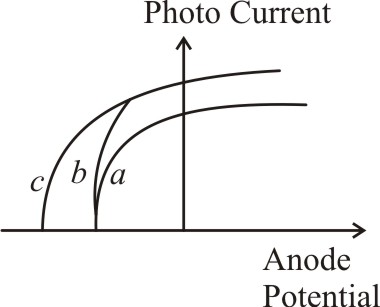| 1. | \(\mathrm{Na}\) only | 2. | \(\mathrm{Cs}\) only |
| 3. | Both \(\mathrm{Na}\) and \(\mathrm{K}\) | 4. | \(\mathrm{K}\) only |
1. work function of material
2. intensity of incident radiation
3. frequency of incident radiation
4. wavelength of incident radiation
In a photoelectric experiment, blue light is capable of ejecting a photoelectron from a specific metal while green light is not able to eject a photoelectron. Ejection of photoelectrons is also possible using light of the colour:
1. yellow
2. red
3. violet
4. orange
Light of a frequency of \(1.5\) times the threshold frequency is incident on a photosensitive material. What happens to the photoelectric current when the frequency is cut in half and the intensity is doubled?
| 1. | four times | 2. | one-fourth |
| 3. | zero | 4. | doubled |
The work function of the photosensitive material is \(4.0~\text{eV}\). The longest wavelength of light that can cause photoelectric emission from the substance is (approximately):
1. \(3100~\text{nm}\)
2. \(966~\text{nm}\)
3. \(31~\text{nm}\)
4. \(310~\text{nm}\)
1. 1.3 V
2. 0.5 V
3. 2.3 V
4. 1.8 V
A source S1 is producing 1015 photons per sec of wavelength 5000 Å. Another source S2 is producing 1.02×1015 photons per second of wavelength 5100 Å. Then, (power of S2)/(power of S1) is equal to:
1. 1.00
2. 1.02
3. 1.04
4. 0.98
2. 3 X 1016
3. 9 x 1015
4. 3 X 1019

| 1. | Curves a and b represent incident radiations of different frequencies and different intensities. |
| 2. | Curves a and b represent incident radiation of the same frequency but of different intensities. |
| 3. | Curves b and c represent incident radiation of different frequencies and different intensities. |
| 4. | Curves b and c represent incident radiations of the same frequency having the same intensity. |
